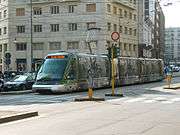Eurotram
The Eurotram was an electric tramcar designed for the tram system of Compagnie de Transports Strasbourgeois (CTS). Initially produced by Socimi, after the company became bankrupt Eurotrams were manufactured by ABB Group's transportation division, later by Adtranz, and then by Bombardier Transportation, and marketed the tram part of its Flexity Outlook range.
Eurotrams have been used on the Strasbourg tramway (France), the Azienda Trasporti Milanesi (Italy), and on the Porto Metro (Portugal).
History and design
The Eurotram light rail vehicles was originally designed for the Compagnie des Transports Strasbourgeois (CTS) specifically for use on the Strasbourg tramway; design requirements included a 100% low floor design, airconditioning, and a higher than usual power to weight ratio for the 8% gradients in the tunnel under Strasbourg's main station. The appearance was styalised by Belgian designer Philippe Neerman.[1]
Tenders for manufacture of the tram led to contracts with ABB Group and SOCIMI (Milan, Italy); SOCIMI subsequently became bankrupt and ABB completed production alone, on the basis of SOCIMI's prototypes; the trams were manufactured at ABB's Holgate works, York and Litchurch lane works, Derby in the UK, with some parts from ABB Trazione (Italy).[1][2]
The tram design was modular, consisting 2.575 metres (8 ft 5.4 in) cabs, 7.550 metres (24.77 ft) passenger units, and 2.350 metres (7 ft 8.5 in) articulation sections. The initial Strasbourg vehicles used seven modules: two cabs, three passenger units and two articulation sections, for a train length of 33.1 metres (109 ft) Each train has a mixture of powered and unpowered bogies;[3] the bogie design used independently rotating wheels, each on a stub axle,[4] the primary suspension was of the radial arm type, and the secondary suspension air spring type.[5] Each wheel of a powered bogie was separately powered by bogie mounted three phase asynchronous motors, connected via a gearbox, with the wheel and motor axises of rotation parallel.[6]
The maximum capacity of the Strasbourg seven module trams was 285 with 66 seated, the nine-module trams had an increased capacity of 370 passengers, with 92 seated.[7] Total installed traction power was 324 and 416 kilowatts (434 and 558 hp)} for the seven and nine module trams.[8]
After the acquisition of Adtranz (ABB transportation group's successor) by Bombardier the design was marketed as part of the Flexity Outlook family.[9]
The Eurotram design was planned to be used on the Nottingham tram system which was under development in 1998.[10] However safety regulations relating to door closing, coupled with the relatively slow motion of the Eurotram's single leaf door meant that the tram would be delayed at stops; an alternative design was chosen, the double leaf doored Incentro tram.[11][12]
In 2003 the design was taken on a marketing tour of Australia, with Porto tram number 018 shortened by 2 modules and put on display in Sydney on the light rail in Sydney.[13] It was then taken to Melbourne where it operated on the local tram network between January and March 2003 as a 7 section tram.[14]
Orders
Twenty-six 33.1m (7 module) Eurotrams were delivered to (Strasbourg tramway) CTS for service on Strasbourg's line A between 1994 and 1995. CTS placed a second order in 1996 for twenty-seven units, nine of which were 7 module trains, and eighteen were 9 module trains.[7]
The Milan tram system (Azienda Trasporti Milanesi) acquired 20 units from Adtranz.[15]
72 units were built for the Porto tram network (Porto Metro) were constructed from 2004 at Bombardier's factory in Amadora Portugal.[9] (see Sorefame.)
Over 150 units were built between 1994 and 2004.[16]
|
References
- 1 2 Wansbeek 2003.
- ↑ Darter & Hall 20095.
- ↑ Darter & Hall 20095, p. 28.
- ↑ Darter & Hall 20095, p. 31.
- ↑ Darter & Hall 20095, p. 28, 41.
- ↑ Darter & Hall 20095, p. 42.
- 1 2 "Strasbourg Light Rail, France", www.railway-technology.com
- ↑ "Fiche Technique Eurotram de Strasbourg" (in French). Retrieved 17 April 2012.
- 1 2 "Metro do Porto Light Rail, Portugal". www.railway-technology.com. Rolling Stock.
- ↑ Armstrong, Pat (August 1998), "Nottingham Express Transit", Tramways & Urban Transit
- ↑ INCENTRO for Nottingham, Light Rail Transit Association, 10 April 2000
- ↑ "Nottingham Express Transit, United Kingdom", www.railway-technology.com
- ↑ "Bombardier Eurotram Exhibition, Sydney". www.sleeper.apana.org.au. Retrieved 2008-07-18.
- ↑ "VICSIG - Trams: Eurotram in Melbourne". www.vicsig.net. Retrieved 2008-07-18.
- ↑ "Milano Metro, Italy", www.railway-technology.com
- ↑ Muller, Georges, Traction Ferroviaire: Les Tramways; Caracteristiques de Materiels Roulants, Ed. Techniques Ingénieur, pp. 7–8
Sources
- Wansbeek, C.J. (March 2003), "Strasbourg: Interurban tram strategy strengthens city system", Tramways and Urban Transit, archived from the original on 20 July 2011
- Darter, Michael I.; Hall, Kathleen Theresa (1995), "Applicability of low-floor light rail vehicles in North America", Transit Cooperative Research Program Report, National Research Council (U.S.). Transportation Research Board (2), ISBN 0309053730
External links
| Wikimedia Commons has media related to Bombardier Flexity Outlook Eurotram. |

.jpg)
.jpg)
